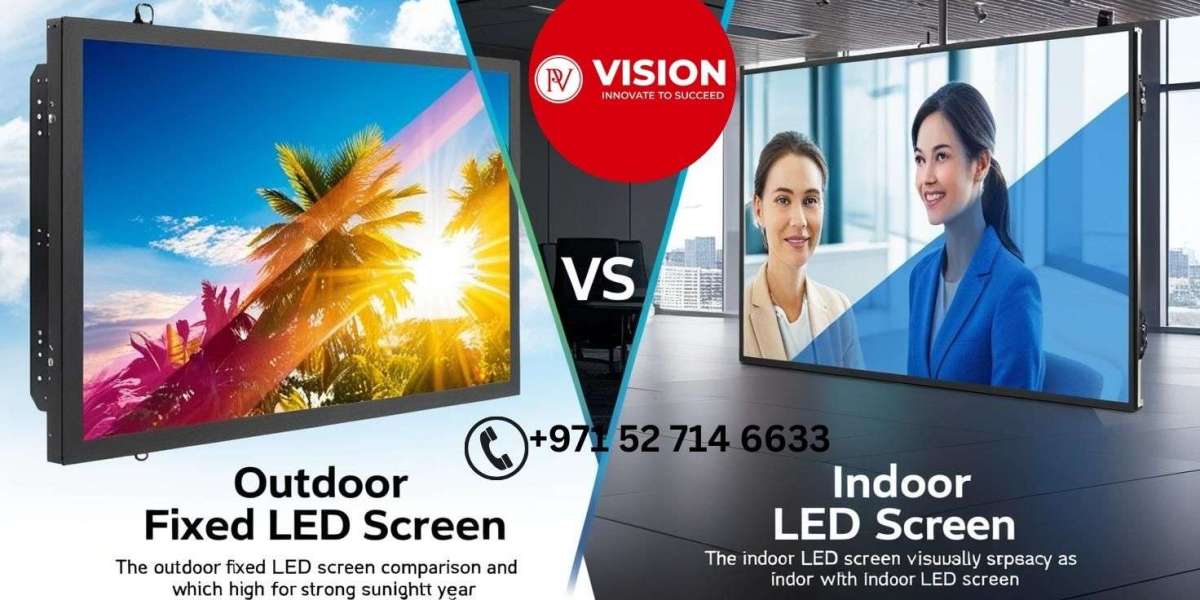What is an Outdoor Fixed LED Screen?
Outdoor fixed LED screen are large digital displays permanently installed in outdoor environments like stadiums, billboards, highways, or building façades. These screens are built to battle the elements—rain, dust, sunlight, wind—you name it.
Read Also:- Outdoor Fixed LED Screen: The Ultimate Guide to Bright & Durable Displays
What is an Indoor LED Screen?
Indoor LED screens are designed to operate within controlled indoor environments like shopping malls, conference rooms, churches, and airports. They focus more on image sharpness and color fidelity than durability against weathe
Key Features Comparison
Brightness Levels
Outdoor screens boast ultra-high brightness (5,000–10,000 nits) so they can compete with direct sunlight. Indoor screens, on the other hand, usually range between 800–2,000 nits—perfect for soft, ambient lighting.
Pixel Pitch
Pixel pitch refers to the distance between LED clusters. Smaller pitch means better image resolution. Indoor screens often have a finer pixel pitch (P1.2 to P2.5), while outdoor screens generally range from P4 to P10 due to the need for long-distance viewing.
Weather Resistance
Outdoor LED screens are IP65+ rated, meaning they’re waterproof and dust-tight. Indoor displays? Not so much—they don’t need to battle weather, so their resistance is minimal.
Durability and Material
Outdoor units use aluminum or die-cast materials with anti-corrosion coatings. Indoor models use lighter and more aesthetic materials suitable for interior decor.
Viewing Distance
Outdoor screens are meant to be seen from afar (20ft+), while indoor screens are viewed up close (3ft–10ft), requiring sharper detail and higher resolution.
Technical Specifications
Power Consumption
Outdoor screens use more power due to higher brightness levels and cooling systems. Indoor screens are more energy-efficient since they don’t need to work as hard.
Cooling Mechanisms
Outdoor displays often come with advanced fans or passive cooling systems. Indoor screens usually don’t need complex cooling—ambient air does the job.
IP Rating (Ingress Protection)
Outdoor: IP65–IP68 (waterproof, dustproof)
Indoor: IP20–IP40 (basic protection against accidental contact and light dust)
Design & Installation
Structure and Enclosure
Outdoor screens require robust metal enclosures and often weigh more. They need to withstand wind pressure and harsh environments. Indoor screens focus on slim, elegant design.
Mounting Requirements
Outdoor LED displays may need poles, concrete bases, or steel frames. Indoor screens often mount directly on walls or ceiling mounts.
Maintenance Access
Outdoor screens allow rear or front access depending on their setup, while indoor screens typically allow easy front maintenance.
Content Display & Usage
Visual Quality and Color Accuracy
Indoor screens typically offer better color depth and sharpness due to fine pixel pitch. Outdoor screens are optimized for brightness, sacrificing a bit of color fidelity.
Audio Integration Differences
Outdoor LED screens usually require external sound systems due to open spaces. Indoor displays often integrate seamlessly with AV systems.
Use Cases and Industries
- Outdoor: Billboards, transportation hubs, sports arenas
- Indoor: Retail, corporate lobbies, exhibitions, control rooms
Cost and ROI Analysis
Initial Investment
Outdoor screens tend to be more expensive due to rugged components and weatherproofing. But they often deliver higher ROI in advertising and public info.
Long-Term Maintenance Costs
Outdoor units may incur more maintenance due to exposure to harsh weather. Indoor units require less frequent servicing.
Longevity & Value
Both types have excellent longevity (5–10 years+), but outdoor displays might degrade faster if not maintained well.
Pros & Cons of Each
Outdoor Fixed LED Screens
Pros:
- High brightness
- Weatherproof
- Long-distance visibility
Cons:
- Higher cost
- Heavier and bulkier
- More energy consumption
Indoor LED Screens
Pros:
- Superior resolution
- Lightweight and elegant
- Lower power usage
Cons:
- Not weatherproof
- Limited viewing distance
- Not suitable for sunlight exposure
Which One Should You Choose?
If you need a screen for a stadium, highway, or outdoor advertising—go outdoor fixed LED. But if your target is indoor promotions, corporate communication, or immersive displays, then indoor is your game.
Still unsure? Consider these:
- Environment: Indoor or outdoor?
- Audience Distance: Close-up or far away?
- Weather Exposure: Yes or no?
- Budget: High for outdoor, moderate for indoor
Future Trends in LED Display Technology
Outdoor Innovations
Expect smarter weather-adaptive displays, solar-powered units, and higher brightness with lower power usage.
Indoor Enhancements
Look out for micro-LEDs, paper-thin flexible screens, and real-time AI content control for retail and events.
Conclusion
Whether you’re lighting up a street corner or a trade show floor, choosing the right LED screen depends on location, audience, and purpose. Outdoor fixed LED screens bring the brawn and brightness. Indoor LED screens deliver finesse and clarity. Make your choice wisely, and your content will shine—literally.
FAQs
- Can I use an indoor LED screen outdoors temporarily?
Not recommended. Indoor LED screens lack the necessary protection from weather and may get damaged. - What is pixel pitch, and why does it matter?
Pixel pitch determines image sharpness. Smaller pitch = better resolution, especially for close viewing. - Are outdoor LED screens visible at night?
Absolutely! They adjust brightness and remain highly visible even in low-light conditions. - How long do LED screens typically last?
With proper care, both indoor and outdoor LED screens can last 5–10 years or more. - What’s the difference in maintenance between the two?
Outdoor screens need more frequent checks due to weather exposure. Indoor ones are lower maintenance overall.



